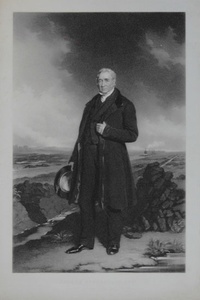| Method | Mezzotint |
| Artist | Thomas Lewis Atkinson after John Lucas |
| Published | London, Published May 23rd 1849 by Henry Graves & Compy. Printsellers in Ordinary to Her Majesty & H.R.H. Prince Albert, 6 Pall Mall. |
| Dimensions | Image 699 x 433 mm, Plate 808 x 530 mm, Sheet 817 x 527 mm. |
| Notes |
George Stephenson (1781-1848), the inventor and founder of railways, was a practical engineer without formal education who became interested in developing more efficient rails and locomotives. In 1814, he tested his first 'steam-blast' locomotive which drew thirty tonnes of coal at four miles an hour. After his pioneering work on the Stockton and Darlington Railway (1825), he won the contract for the Manchester and Liverpool Line in 1826. The success of both lines was increased by the newly designed Rocket (1829), an engine which travelled at 29 miles per hour. The building of these two lines prompted immense business speculation and an expansion of the railway system which transformed the British countryside and economy. Thomas Lewis Atkinson (1817 - 1898) was a line and mezzotint engraver, and a pupil of Samuel Cousins. John Lucas (1807-1874), portrait painter, began his career as an apprentice to mezzotint engraver Samuel William Reynolds. When his tenure with Reynolds ended in the late 1820s, Lucas established a practice as a painter. He exhibited his first portrait at the Royal Academy in 1828 and thereafter gained fame as a fashionable society portraitist. Lucas often exhibited his works publicly, showing ninety-six portraits at the Royal Academy from 1828 to the time of his death. O'Donoghue 6, Printsellers' Association Index 361, Lennox-Boyd v/v Ex. Col.: Hon. Christopher Lennox-Boyd. Condition: Trimmed close to platemark, light foxing to sheet. |
| Framing | unmounted |
| Price | £400.00 |
| Stock ID | 34924 |

